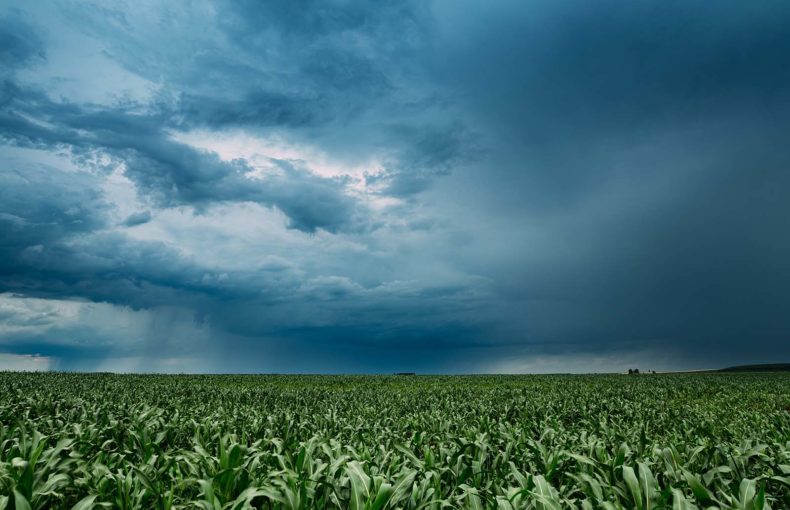Machine learning brightens weather forecasting’s future
Neural networks show great potential in boosting the performance of numerical weather predictions.
Weather is typical, until it isn’t
There is something strange about the weather. On one hand, we know it follows predictable patterns governed by nature’s laws. On the other hand, it sometimes behaves in ways that appear illogical. A frigid night interrupts a warm summer’s week. A storm barrelling north suddenly swings west. It is enough to make your head spin.
To make sense of the complexity, civilizations have relied on the best tools available, from omens and lore to barometers and weather balloons. But sorting out the details is no easy task.
“As a computational problem, global weather prediction is comparable to the simulation of the human brain and of the evolution of the early Universe,” wrote scientists in Nature.
One of the latest innovations to support weather forecasting is machine learning. Unlike previous methods, it does not rely on humans to theorize correctly about the planet’s weather system. Instead, experts use neural networks to study data and develop solutions. This technique could provide a valuable and efficient method to boost the accuracy of today’s standard forecasting technique, known as numerical weather predictions. And its early successes point to rewarding opportunities.
“We want to provide customers with the best accuracy models that we can,” said Razvan Stefanescu, head of statistics and machine learning at Spire Weather. “Here at Spire, we are combining both numerical weather prediction and neural networks to improve the accuracy of the weather forecasts.”
“Informing the neural network with physics constraints holds a great promise in improving the weather forecasts.”
Share on Facebook Share on Twitter Share on LinkedIn
Looking back to see the future of forecasting
The origins of numerical weather prediction reach back to 1904 when Norwegian physicist Vilhelm Bjerknes theorized that it was possible to forecast the weather by solving a set of equations, the National Oceanic and Atmospheric Administration wrote in a history of the technique. A few years later, British mathematician Lewis Fry Richardson put the theory to the test, crunching numbers for six weeks to produce a six-hour forecast—all while working with an ambulance unit in France during World War I.
Today, leading national and international weather institutions use supercomputers instead of slide rules. For example, NOAA plans to upgrade to a system with 40 petaflops of computing capacity, meaning it can do 40 quadrillion (one with 15 zeros after it) operations a second. But the process follows the same basic steps as it did decades ago.
First, experts collect measurements from sensors about the atmosphere’s current state, combining readings of temperature, humidity, pressure, and a range of other variables through statistical techniques. They then feed this initial state into a numerical model that simulates the evolution of the atmosphere, which include physics and mathematics equations. These equations encompass Newton’s laws, thermodynamics, microphysics, and other physical approximations that scientists have created to describe how meteorological variables change with time. Finally, the model’s solutions become the forecasts we see on the daily news or smartphone applications.
“A numerical weather prediction system is like a great wonder of the world,” said Stefanescu. “However, there are many aspects that need to be improved.”
Machine learning can help.
“We can improve on our best knowledge as time continues.”
Share on Facebook Share on Twitter Share on LinkedIn
Let the neural net handle that
Machine learning lets computers take a crack at decision-making. Instead of scientists finding equations to explain a phenomenon, neural networks identify patterns in data and develop answers independently. It tends to be ideal for decoding complex scenarios with massive amounts of data—just like the weather.
“Neural networks are very flexible, which means you don’t need to make strong guesses about how weather systems are going to behave,” said Matthew Lennie, a machine learning engineer at Spire Weather. “The flexibility allows the neural network to fit itself to the situation and find the pattern. Think of it like mathematical play-dough.”
These systems show potential in aiding multiple stages of numerical weather predictions. They might help with automated quality control, model errors, faster physics approximations, and improved optimizers. And they could assist engineers with fine-tuning models.
“Informing the neural network with physics constraints holds a great promise in improving the weather forecasts,” said Stefanescu.
Spire is already finding success using a machine learning program called JUNO to boost ensemble forecasting.
In ensemble forecasts, meteorologists combine the results of multiple models into one prediction. Each model has strengths and weaknesses, with some performing better in certain regions than others. By combining them, forecasters hope to get the best of all available forecast options. But determining when and where one model performs better than another is complicated. After all, numerical weather predictions track the evolution of hundreds of variables throughout the atmosphere and into the future.
With JUNO, Spire leaves the complexity for a neural network to sort out. The program compares the various predictions with observed results and then determines how to rank each model’s results. Multiple weather variables are used to correct the forecasts’ biases, Stefanescu explained. For example, JUNO does not just look at the relationship between predicted temperature and measured temperature. It also studies how pressure, wind, humidity, and other conditions impact a temperature prediction. The process is data-driven and makes fewer assumptions than with traditional approaches, said Stefanescu.
“This intelligent voting system starts to work out which predictions are the best in each scenario, creating a better quality prediction than each one alone or an average of the group,” said Lennie.
Bespoke forecasting
One day, machine learning might help tailor forecasts to meet the needs of specific industries.
“Markets have different wishes of what they want from models,” Lennie said. “It helps to have this system so we can customize and build the best version of the forecast that is reliable for that particular industry.”
Take the unique forecasting demands of the renewable wind energy industry, for example. In this industry, over-predicting the wind can lead an organization to sell more power than it can generate, Lennie explained. With machine learning, it should be possible to tailor the ensemble forecast to provide conservative forecasts, which can help customers avoid the risks of over-committing. Lennie said the systems might even help provide wind turbine operators with a probabilistic output to help them further balance risk and reward.
On the other hand, a fire department might want to know about even a slight chance of high winds that could stoke and spread a wildfire. The earlier the warning, the better. In this case, machine learning might prioritize forecasts that show any chance of heavy winds while also honing in on temperatures highs and humidity lows—spotting conditions that make wildfires more likely.
Better yet, these systems will improve as engineers feed them with more data. Spire has no shortage of that. It operates over 100+ nanosatellites that gather observations around the world. These satellites already make radio occultation measurements, collecting detailed atmospheric data that can help reduce weather forecasting errors. As Spire launches more devices and capabilities, the constellation will produce more information.
“We can improve on our best knowledge as time continues,” said Lennie.
Meteorologists and machine learning scientists are sure to discover new ways of using neural networks and data to optimize numerical weather predictions. The fields show the potential of growing together and building on each other’s successes, with the hybrid systems becoming better at predicting unexpected events and nuanced occurrences.
“This is the future no matter what,” said Stefanescu.
Watch our Wildfire Prediction & Observation Use Case:
Spire Weather is constantly customizing its predictive weather models to help power your most ambitious projects.



